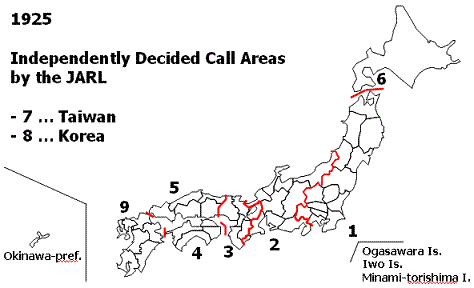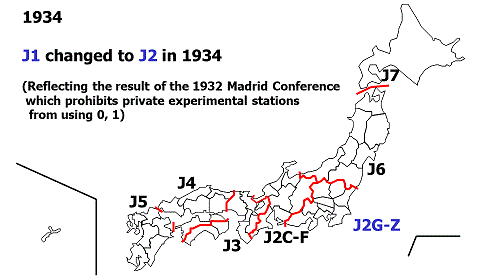
The history of the Japanese call sign system goes back about 75 years, and their story is more complicated than most amateurs realize. At first there was no licensing of radio stations in Japan. Pioneer amateurs made up their own calls.
In the spring of 1925, Takeo Kawahara, an engineer in the Iwatsuki Radio Station of the Ministry of Communications decided his call sign as J1AA to try a short wave communication. This call sign based on the US call area system which had been already created in 1912 [DEMPA 1993][QST]. Finally, the Iwatsuki achieved a two-way communication on 79-m with Frank Macik, u6BBQ in Pasadena, CA on April 6, 1925 [J1AA]. It was the first ever overseas short wave communication for Japan.
An alternative explanation of the record was referred for a long period as follows —
The Iwatsuki was able to catch a 90-m short wave communication by RCA between W6XI in Honolulu and W6XO in San Fransico first, and next tried a two-way communication on 80-m. Finally the Iwatsuki got a call by Horace Wilsert, u6RW in San Francisco at 2AM PST on April 8, 1925 [JA1FRA 1976b].
In the fall of the same year 1925, the other guys in the Kansai (Osaka) area separately decided their call signs. Koichi Kasahara, an university student in the Kansai Gakuin living in Kobe selected JFMT imaging a cartoon "Mutt & Jeff," and Ken'ichi Kajii, an engineer in Sumitomo Cable living in Osaka selected JAZZ loving the light music.[DEMPA 1993][JA3HXJ]
ARRL had already submitted the internationally accepted "International Intermediates" system in 1924, in which listed up Japan as J. But any of the Japanese amateurs had not known it so that they adopted the J by accident [DEMPA 1987].
| Call Sign | Operator | Remarks |
|---|---|---|
| J1AA | Takeo Kawahara | since Spring 1925 |
| JFMT | Koichi Kasahara | since Fall 1925 |
| JAZZ | Ken'ichi Kajii | since Fall 1925 |
The story above is surely the Episode I in the Japanese call sign journey on which we start. Takeo Kawahara, the first operator, next established another station as J1PP imaging "Post office Phone" to try radio telephone and made the first overseas phone contact on December 19, 1925 [JA1FRA 1976b][AYUMI]. He became an executive director in Nihon Short wave Broadcasting in his later years [JA1FRA 1976a].
Japanese amateurs organized the Japana Amatora Radio Ligo (JARL)—in Esperanto—in June 1926 [AYUMI][DEMPA]. Not the authority but the JARL decided the first call area system 1-9 in its own rule [AYUMI]. They had punningly assigned 4 for Shikoku (meaning "four-province") Island, and 9 for Kyushu ("nine-province") Island. In addition, Taiwan (Formosa) having been merged to Japan 1895-1945 had 7 and Chosen (Korea) 1910-1945 had 8. But ARRL List of Countries treated them separated ones.

Because Japan had no amateur radio regulations yet, while the US already had the Radio Act of 1912, the Japanese operator could choose his initials as the suffix.
| Call | Operator | Call | Operator | Call | Operator | Call | Operator | Call | Operator |
|---|---|---|---|---|---|---|---|---|---|
| 1FM | Sato | 1KB | Kabayama | 1KM | Miyazaki | 1KO | Morimoto | 1KW | Miyajima |
| 1LT | Hagio | 1MO | Inoue | 1MT | Takayama | 1MU | Sumi | 1NE | Eimura |
| 1SA | Akuzawa | 1SH | Shima | 1SK | Takada | 1SM | Mori | 1SO | Iso |
| 1TN | Nakagiri | 1TS | Semba | 1TT | Takeda | 1UU | Utsuki | 1WW | Horikita |
| 1WY | Yamamoto | 1YH | Hoshino | 1ZB | Yagi (ex JQZB) | 1ZQ | Imaoka | 1ZQ (successional) | Osaka |
| 2BB | Arisaka | 2CB | Yamaguchi | ||||||
| 3AA | Kasahara (ex JFMT) | 3AZ | Kajii (ex JAZZ) | 3BB | Ibuka | 3CC | Yamaguchi | 3KI | Kikuchi |
| 3KK | Kusama | 3QQ | Yamaguchi | 3ST | Takejima | 3WW | Tanikawa | ||
| 4TO | Sato | ||||||||
You can find Masaru Ibuka, the founder of SONY as 3BB.
On March 1, 1927, the authority first licensed JLYB as a "Private Radio Telegraph and Telephone Experimental Station" for Iwao Arisaka, ex-2BB, a navy captain. He was the father of Hideo, JA1AYZ and Yoshio, JA1HQG. JLZB was also assigned on that day [JA1AN 22].
| Call Sign | Licensee | Remarks |
|---|---|---|
| JLYB | Iwao Arisaka | a navy captain |
| JLZB | Tetsuhide Kusumoto | a government official in the Ministry of Communications |
The "real" amateurs did not assume these experimental stations as amateur radio stations because they ware licensed for government related persons, but they were virtually amateur radio stations.
From September to November in the same year 1927, the authority officially licensed ten other stations as "Private Radio Telegraph and Radio Telephone Experimental Stations on Short Wave" with the call signs like JX$X at last. For example, Kankichi Kusama, former 3KK got a new call sign JXAX.
| Call Sign | Licensee | Date (1927) | Communications Ministry Notification # | Remarks (Unofficial Call Signs) |
|---|---|---|---|---|
| JXAX | Kankichi Kusama | Sept. 10 | #2002 | ex 3KK |
| JXBX | Takeshi Semba | Oct. 7 | #2248 | ex 1TS |
| JXCX | Noboru Eimura | Oct. 7 | #2247 | ex 1NE |
| JXDX | Shiro Akuzawa | Oct. 7 | #2251 | ex 1SA |
| JXEX | Haruo Horikita | Oct. 7 | #2249 | ex 1WW |
| JXFX | Momoki Sumi | Oct. 7 | #2250 | ex 1MU |
| JXGX | Toshio Seki | Oct. 8 | #2277 | |
| JXHX | Hikotaro Takeuchi | Oct. 7 | #2246 | |
| JXIX | Koichi Kasahara | Nov. 14 | #2505 | ex JFMT → ex 3AA |
Radio Amateur Call Book Magasine in September, 1928 reflected these stations with a statement of "All QSL cards for Unlicensed Stations not listed here should be in an envelope, with no mention of 'Radio' or the station call." [AYUMI]
A next call sign system for amateurs was adopted, because the Washington Conference of 1927 had decided that experimental stations should have call signs of a prefix followed by a number. The authority put up this announcement on October 19, 1928 [AYUMI]. And moreover, the conference had launched the international system of call sign prefixes, so J eventually became the Japanese official prefix.

The authority issued new format call signs for existing amateurs as follows (Issued Oct. 19, 1928; Effective Jan. 1, 1929). And on the next day and after, new stations got the new format call signs (eg. J3CC-CH are issued on Oct. 20, 1928).
| Call Sign | Licensee | Remarks |
|---|---|---|
| J1CU | Tetsuhide Kusumoto | ex JLZB |
| J1CV | Iwao Arisaka | ex JLYB |
| J1CW | Hikotaro Takeuchi | ex JXHX |
| J1CX | Haruo Horikita | ex 1WW → ex JXEX |
| J1CY | Shiro Akusawa | ex 1SA → ex JXDX |
| J1CZ | Noboru Eimura | ex 1NE → ex JXCX |
| J1DA | Semba Takeshi | ex 1TS → ex JXBX |
| J1DB | Momoki Sumi | ex 1MU → ex JXFX |
| J1DC | Toshio Seki | ex JXGX |
| J1DE | Tokichi Kunigome | ex JMPB |
| J3CB | Kankichi Kusama | ex 3KK → ex JXAX |
| J3DD | Koichi Kasahara | ex JFMT → ex 3AA → ex JXIX |
The authority allocated J#CA- for private stations, and the beginning part in it for private company stations in each area (ie J1CA-J1CT and J3CA). For example, J1CA was Annaka Electric Corporation and J3CA was the Mitsubishi Shipbuilding Kobe Docks. On the other hand, governmental experimental stations used the top letter As and Bs [JA1AN 3]. For example, Tokyo Metropolitan Police had J1AB, and Saitama Prefectural Office had J1AD. Communications training centers were J#AK-, and Schools were J#BA- [AYUMI].
On February 1, 1934 [JA1BWA][JN 34-2], the first call area merged with the second as the new J2 area, because the Madrid Conference of 1932 had decided that private experimental stations should avoid numerals 0 and 1 in their call signs. Because Japan's authority defined amateurs not as amateur stations but as "private experimental stations" before the war, in the first call area, every amateur station had to change the call sign to J2GA-, although amateur stations outside Japan could maintain numerals 0 and 1 continuously without any problems [AYUMI].

On October 15, 1936, the Ministry of Communications devided their "Tokyo Bureau" into "Tokyo Metropolitan Communications Bureau" and "Tokyo Rural Communications Bureau;" and moved Niigata-prefecture from under the control of the "Sendai Regional Communications Bureau" to "Tokyo Rural Communications Bureau." So stations within Niigata changed their call sgin from J6 to J2 on December 1, 1936 (Notified on November 28, 1936).

The authority licensed J2UA inland on February 22, 1941 and J8PN in a foreign part on July 24, 1941, at the end, and after then suspended licensing. Amateur Radio was shut down on December 8 (JST), 1941, as it was in other countries of the world.